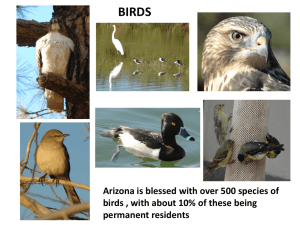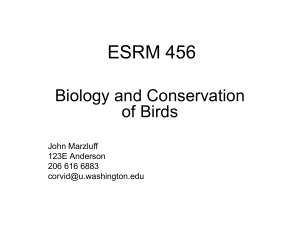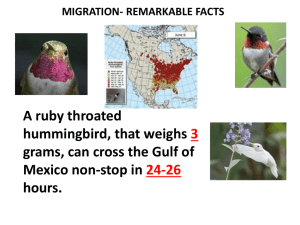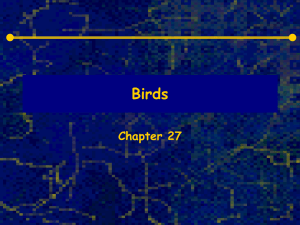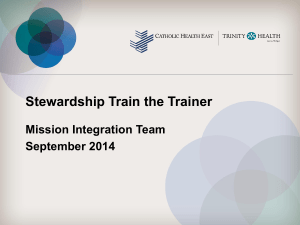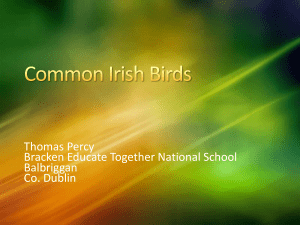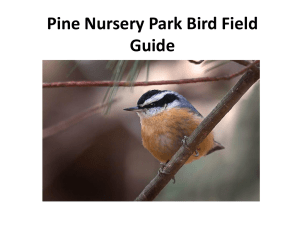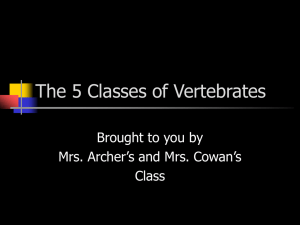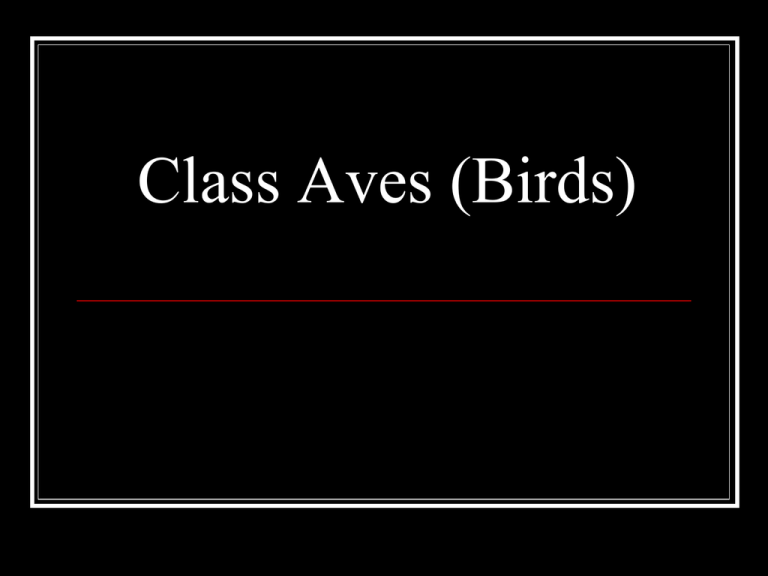
Class Aves (Birds)
Class Aves (Birds)
–
Zoologists that
study birds
Ornithologist
Characteristics of Birds
Vertebrate
Feathers
Wings (but not all fly)
Scale-covered legs
Homoeothermic (Keeps their body
temperature at one temperature)
Endothermic (Warm blooded)
Designed For Flight.
The following characteristics equip birds for
flying:
Compact, lightweight, and very strong
skeleton
Designed For Flight.
Lightweight beaks
and skulls.
Designed For Flight.
A nearly rigid backbone that gives a solid
support for the strenuous muscle activity
required for flying
Designed For Flight.
Hollow spaces in the
skeleton that provide
room for air sacs, which
contribute to the
efficiency of the
respiratory system and
make the bird lighter.
Designed For Flight.
Bipedal (“twofooted”)
anatomy, which
leaves the wings
free for flying.
Designed For Flight.
A prominent ridge, or
keel, on the breastbone
to allow for the
attachment of flight
muscles by strong
tendons.
Designed For Flight.
Three bones in the shoulder to support
each wing.
Designed For Flight.
An efficient circulatory system, including a
four-chambered heart.
Designed For Flight.
Powerful muscles to power the wings
during flight.
Perching Birds –
Three toes pointing forward and one toe
pointing backward.
Leg has a special design that allows the
bird to stay on their perch even if they are
sleeping.
Diagram of Perching Bird’s Leg
Thrushes
Robins
Bluebird
Goldfinch
House Sparrow
Humming Bird
Woodpecker
Birds of Prey Especially acute eyesight
Sharp, Powerful talons (grasping and
killing their prey)
Hooked Beak
Vultures
California Condor
Sea Eagle
Bald Eagle
Golden Eagle
Hawks
Osprey
Falcons
Owls
Swimming and Wading Birds –
Many have water repellent feathers
Webbed or Lobed feet for swimming
Some Birds have very long legs designed
for wading
Ducks
Geese
Storks
Herons
Flamingos
Cranes
Egrets
Game Birds –
Have been hunted for food and sport
Large flight muscles (Breast meat) allow
them to burst into flight
Quail
Pheasant
Partridge
Grouse
Doves
Turkey
Tropical Birds –
Live in the world’s tropical forests
Brightly colored
Many have large unusual beaks
Parakeets
Toucans
Macaw
Flightless Birds
Have wings or wing-like structures
Usually equipped with powerful legs for
running
Ostrich
Emu
Kiwi
Penguins
Extinct Birds
Some became extinct because of the
pressures put on their habitat
Some have been extinct for thousands of
years
Dodo
Moa
Great Auk
Passenger Pigeon
Archaeopteryx
Diatryma
Avian Anatomy and
Physiology
Function of Feathers
Lightweight
body covering that is an
excellent insulator
Smoothly tapered,
streamlined shape
Broad surface area
of wings allow for lift
Types of Feathers
Feather – Strong feathers
found on the
bird’s body, wings,
and tail
Contour
Types of Feathers
Flight Feather – A special contour feather
that provides the necessary wing shape
for flight
Types of Feathers
Down Feather – Soft fluffy feathers close
to the birds body to provide great
insulation without adding much weight
Types of Feathers
All feathers are pointed to the bird’s tail to
aid in streamlining
Parts of the Feather
Calamus – The shaft in the middle of the
feather that attaches to the bird.
Parts of the Feather
Rachis – The long shaft in the middle of
the feather that the barbs attach to.
Parts of the Feather
Barbs – Small projections coming off the
rachis which have barbules with hooks or
flanges coming off of them
Parts of the Feather
Barbules – Small
projections coming off
the barb that hook
together with the
barbules of the next
barb
Parts of the Feather
Vane – All of the Barbs on one side of the
rachis
The Incredible Feather
By design, a feather can change shape
during flight in response to different
pressures in the air
The Incredible Feather
Most of the feathers are designed to give
lift
Some feathers are designed as ailerons
and flaps to control direction and give
extra lift.
The Incredible Feather
The tail feathers serve as a rudder and
elevator to control flight direction.
The Incredible Feather
There are nerve endings near the end of
each feather that turn the feathers into
sensory receptors
Flight Patterns
Powered Flight – Flap with a downward
stroke of the wings to produce lift
Flight Patterns
Gliding – Use of the air movement to “fall”
slowly and gracefully
Flight Patterns
Soaring – Use of the thermal up-currents
to rise in a circular pattern. Birds can dive
and start climbing again
Flight Patterns
Special Flight Patterns – Complicated
motion of the wings produce a vertical,
reverse or hovering flight. (Hummingbird
and Skylark)
Specially Designed Skeletal System
Many bones are hollow and filled with air
instead of marrow
Specially Designed Skeletal System
The hollow bones are strengthened with
internal cross bracing
Specially Designed Skeletal System
Birds have a blade-like sternum or
breastbone that the large muscles
responsible for flight attach to
Specially Designed Muscular System
Very large pectoralis major muscle
powers the downward stroke that gives
the bird lift
Specially Designed Nervous System
Usually have a poor sense of taste and
smell
Specially Designed Nervous System
Their sense of hearing is very good.
Because of the need to distinguish
between the differences of different bird
calls the bird needs to be able to
distinguish differences in intensity and
rapid fluctuations in pitch
Specially Designed Nervous System
Most birds have very good eyesight
Instead of moving their eyes in their head
they will move their whole head
Specially Designed Nervous System
They have a third eyelid called a
nictitating membrane that is transparent
and allows the bird to blink to moisten its
eyes in flight.
Nictitating Membrane
Nictitating Membrane
Nictitating Membrane
Specially Designed Nervous System
Nocturnal birds have extraordinary night
vision.
Specially Designed Digestive System
Relative small size and great activity
requires a great deal of fuel
Specially Designed Digestive System
Birds absorb a very high percentage of
the food they eat.
Specially Designed Digestive System
Different birds have different bills
designed for what they eat
Specially Designed Digestive System
Birds are able to eat and digest their food
quickly
Special Parts of the Digestive System
Crop – Many birds have a special sac in
their esophagus that serves as a storage
chamber.
Special Parts of the Digestive System
Gizzard – A chamber of the digestive
system found after the stomach that is
muscular, has horny plates, and
sometimes contains grit to help grind the
food up.
Special Parts of the Digestive System
Cloaca – Area of the digestive system
where the waste is expelled. Also where
the sperm is received for reproduction,
where the eggs are released and where
the wastes from the kidneys are released.
Specially Designed Excretory System
Birds produce uric acid instead of urea.
This does not have to be dissolved in
water and keeps water in the bird.
Specially Designed Excretory System
Birds release their uric acid through the
cloaca
Specially Designed Excretory System
Some birds have a salt gland, which takes
salt out of their body and puts it into a
salty solution that runs through a duct in
the nostril.
Specially Designed Excretory System
The salt gland allows marine birds to get
the water they need by drinking seawater
Specially Designed Circulatory System
Have a four-chambered heart
Have a high metabolism to keep the body
at a constant temperature, so they have a
rapid heartbeat
Specially Designed Respiratory System
The respiratory system is completely
different from every other living vertebrate.
Specially Designed Respiratory System
Breathes “through” their lungs instead of
“into” their lungs
Lungs do not expand or contract
Specially Designed Respiratory System
With this different way of breathing, birds
are able to take more oxygen out of the air
Specially Designed Respiratory System
Respiratory system allows birds to fly at
high altitudes and have enough oxygen
Specially Designed Respiratory System
The air sacs of birds are used to cool the
body during flight.
Specially Designed Respiratory System
The bird’s “voice box” (syrinx) has a
membrane that vibrates when air passes
over it.
Family Life of Birds
Migration
Migration – the annual movement to a
different region
What we know about Migration
1.Migrating birds follow the same route each
year (These are called Flyways)
What we know about Migration
2.A keen sense of
direction and
recognition of
landmarks seems to be
involved
What we know about Migration
3.The position of stars
and constellations
guide many migrating
birds.
What we know about Migration
4.The earth’s magnetic
field helps guide certain
birds
What we know about Migration
5.The length of the day
has a bearing on the
migratory instinct
What we know about Migration
6.The urge to migrate may be related to
breeding and development of sex organs
What we know about Migration
7.Migration generally occurs in the spring
and fall
What we know about Migration
8.Most migration is north and south
North American Blue Grouse
Migrates about 300
miles, one of the
shortest
Arctic Tern
Migrates 11,000 miles
each time from
Antarctica to the Arctic
Courtship
Depending on the
species, males
display some form of
behavior that attracts
the female.
Color (Frigate Bird)
Plumage (Superb Bird of Paradise)
Plumage (Peacock)
Song
Nesting
Most birds build a new nest for every new
brood
There are about as many different nests
as there are species of birds
Robin nest
Made of twigs and
grass
Barn Swallow nest
Made of mud
Killdeer nest
Made of stones
Oriole nest
Nest hangs from
branches
Osprey nest
High, built near water
Nesting (Sparrow Eggs)
Nesting is done for the protection of eggs
Parts of the Egg
Yolk – A food source rich in fat
Embryo – Living part of the egg
Germinal Spot – Special area where the
embryo develops
Parts of the Egg
Shell – Protective covering of the egg with
tiny pores that allow for diffusion of
oxygen, water vapor, and carbon dioxide.
Parts of the Egg
Chalaza – Twisted cord that supports the
yolk and makes sure that the germination
spot is always facing up.
Parts of the Egg
Albumen – Egg white. Surrounds the
yolk.
Air Chamber – Small amount of air inside
the shell
Diagram of an Egg
Diagram of an Egg
Incubation
Incubation –keeps eggs warm so the
young will develop properly
Incubation
Brood Patch – a
patch of skin where
an adult loses
feathers on its belly
to transfer heat to
the egg
Incubation
The bird instinctively
senses the temperature
within the egg and
adjusts it accordingly
Emperor Penguin
Emperor penguin
keeps the egg at 93
degrees for 8-9 weeks
with air temperatures
at 77 below 0
Hatching
Altricial – Birds are naked and helpless at
birth (Robins, Blue Jays, Cardinals)
Hatching
Precocial – Birds that are covered with
down and are able to run or swim
immediately after hatching (Ducks,
Geese, Killdeer)
Feeding
Some birds will wait
with their mouths
open.
Feeding
Parents will store food in their crop and
“regurgitate” it for the birds
Feeding
Some young birds
reach into their
parent’s mouth to eat
Feeding
Doves and pigeons produce crop milk rich
in protein and fat
The flamingo produces an oily fluid in their
digestive tracts to feed their young
Flamingo about to receive crop milk

